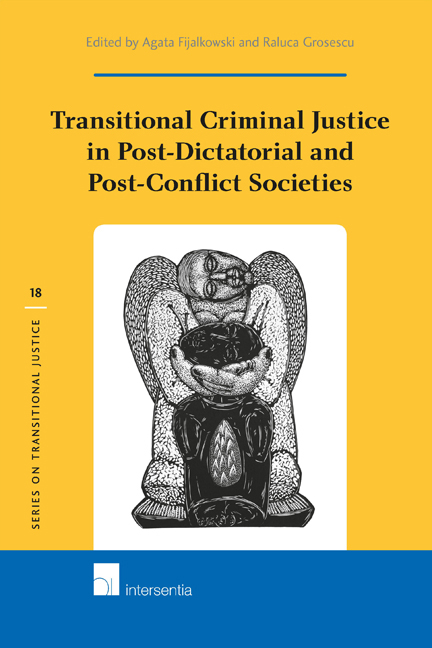Book contents
- Frontmatter
- Contents
- Introduction
- PART I CRIMINAL JUSTICE AS A METHOD OF DEALING WITH THE PAST: OPPORTUNITIES, STRATEGIES, AND LEGAL AND POLITICAL CONSTRAINTS
- Chapter 1 Retrospective Justice: Post-Communist Germany and Poland in Comparative Perspective
- Chapter 2 Transitional Justice in Nepal: Prosecutions, Reform and Accountability Strategies
- Chapter 3 Transitional Trials as History Writing: The Case of the Romanian December 1989 Events
- Chapter 4 Transitional Criminal Justice: The Polish Way
- Chapter 5 Public Contestation and Politics of Transitional Justice: Poland and Albania Compared
- Chapter 6 Consolidating Democracy Through Transitional Justice in Slovenia: Lessons Learnt?
- PART II UNIVERSAL PRINCIPLES V LOCAL PECULIARITIES: THE RELATIONSHIP BETWEEN NATIONAL JURISDICTIONS AND INTERNATIONAL LAW
- About the Authors
Chapter 2 - Transitional Justice in Nepal: Prosecutions, Reform and Accountability Strategies
from PART I - CRIMINAL JUSTICE AS A METHOD OF DEALING WITH THE PAST: OPPORTUNITIES, STRATEGIES, AND LEGAL AND POLITICAL CONSTRAINTS
Published online by Cambridge University Press: 28 November 2017
- Frontmatter
- Contents
- Introduction
- PART I CRIMINAL JUSTICE AS A METHOD OF DEALING WITH THE PAST: OPPORTUNITIES, STRATEGIES, AND LEGAL AND POLITICAL CONSTRAINTS
- Chapter 1 Retrospective Justice: Post-Communist Germany and Poland in Comparative Perspective
- Chapter 2 Transitional Justice in Nepal: Prosecutions, Reform and Accountability Strategies
- Chapter 3 Transitional Trials as History Writing: The Case of the Romanian December 1989 Events
- Chapter 4 Transitional Criminal Justice: The Polish Way
- Chapter 5 Public Contestation and Politics of Transitional Justice: Poland and Albania Compared
- Chapter 6 Consolidating Democracy Through Transitional Justice in Slovenia: Lessons Learnt?
- PART II UNIVERSAL PRINCIPLES V LOCAL PECULIARITIES: THE RELATIONSHIP BETWEEN NATIONAL JURISDICTIONS AND INTERNATIONAL LAW
- About the Authors
Summary
There have been few instances of transitional justice in Asia, with the exceptions of the hybrid criminal tribunals in Cambodia and Timor-Leste and truth and reconciliation commissions established in South Korea and Timor-Leste. Adding to this nascent trends are proposals for accountability in Nepal. This chapter examines transitional justice commitments in Nepal following its Comprehensive Peace Agreement in 2006. It specifically scrutinises the suitability and viability of prosecutions as a transitional justice strategy in Nepal. It concludes that despite progressive decisions of the Nepalese Supreme Court incorporating international human rights law, the prospect for viable prosecutions remains negligible. In particular, this chapter argues the following three points. First, the present legal framework disables the pursuit of criminal accountability for gross violations of human rights, in particular torture and enforced disappearances in Nepal, Secondly, efforts at criminal accountability and criminal law reform are hindered by the absence of political accountability and interference in the legal sector. And, finally, in the short and medium terms, alternative and softer forms of accountability may be more profitably pursued in Nepal while consolidating support, expertise and information for future prosecution strategies.
HISTORICAL CONTEXT: NEPAL's CONFLICT AND TRANSITION TO PEACE
Before we examine these assertions, it may be useful to provide some context of the Nepal and its legal system. A hereditary monarchy has ruled Nepal as a largely closed state for most of its history. In 1951, the first claim was made for a Nepalese constituent assembly to broaden the nature of politics and governance. The 1959 Constitution vested political power in the King and the Prime Minister alone, with cursory and diluted powers given to the legislature. The 1962 Constitution replaced this concentration of power with the ‘Panchayat’ system, which effectively excluded a legislature and ensured that the Prime Minister was beholden to the King. This system gave rise to significant public criticism, generating the need for concessionary constitutional reforms in 1980, devolving some powers to a national legislature and ensuring the appointment of the Prime Minister and his cabinet from the said legislature. The new system was often criticised for being unrepresentative, corrupt, and generating massive inequality between urban and rural areas and for concentrating power in urban state agencies. Challenges to this system emerged in the People's Movement of 1990, in which tens of thousands of protestors from across the political spectrum demonstrated in Kathmandu.
- Type
- Chapter
- Information
- Publisher: IntersentiaPrint publication year: 2015



